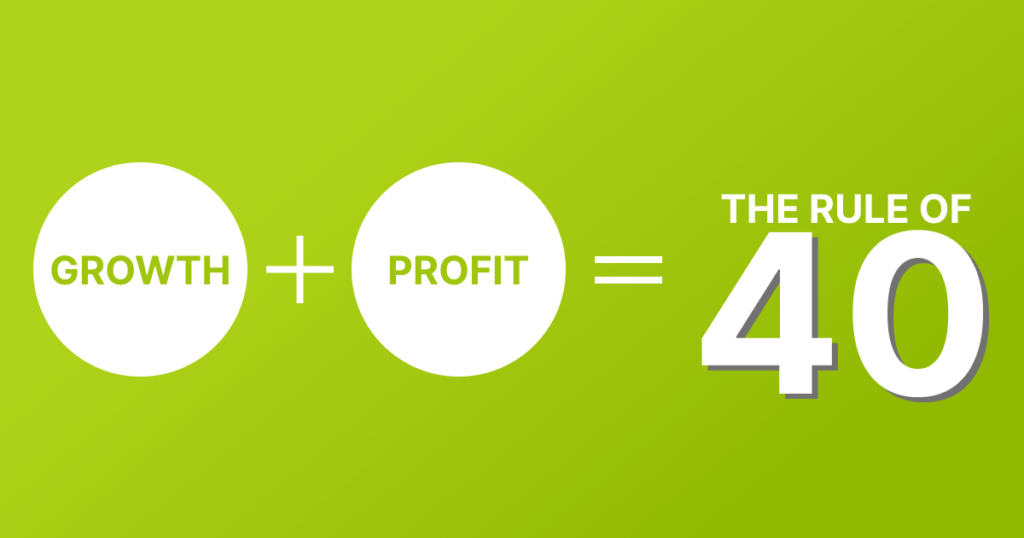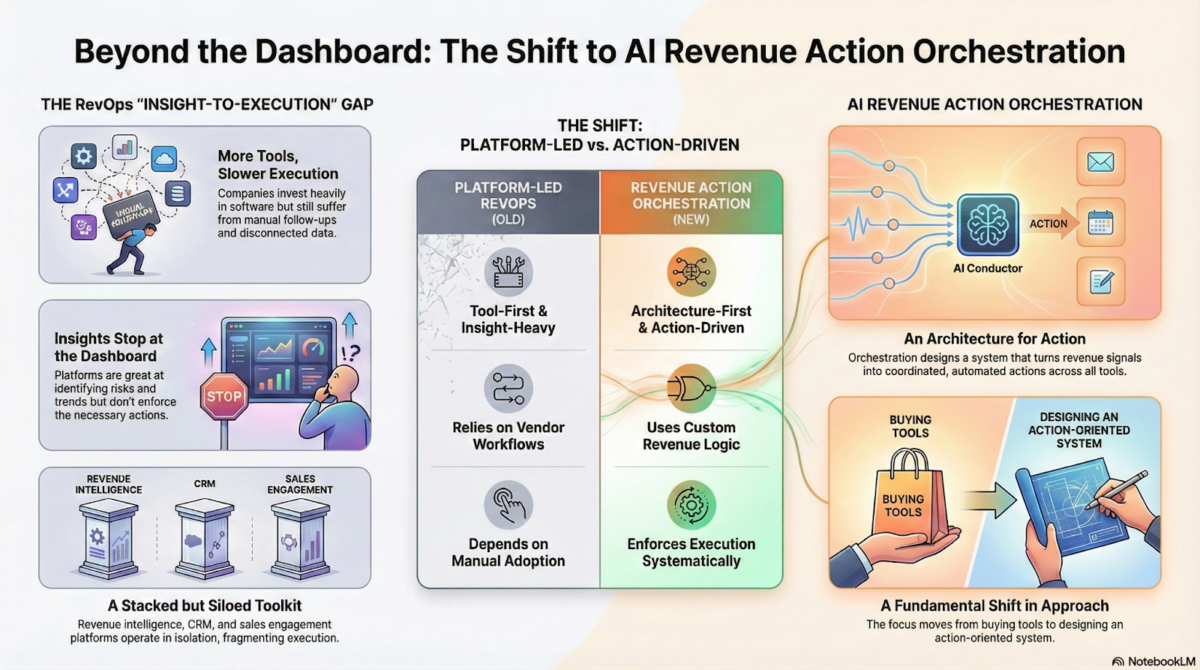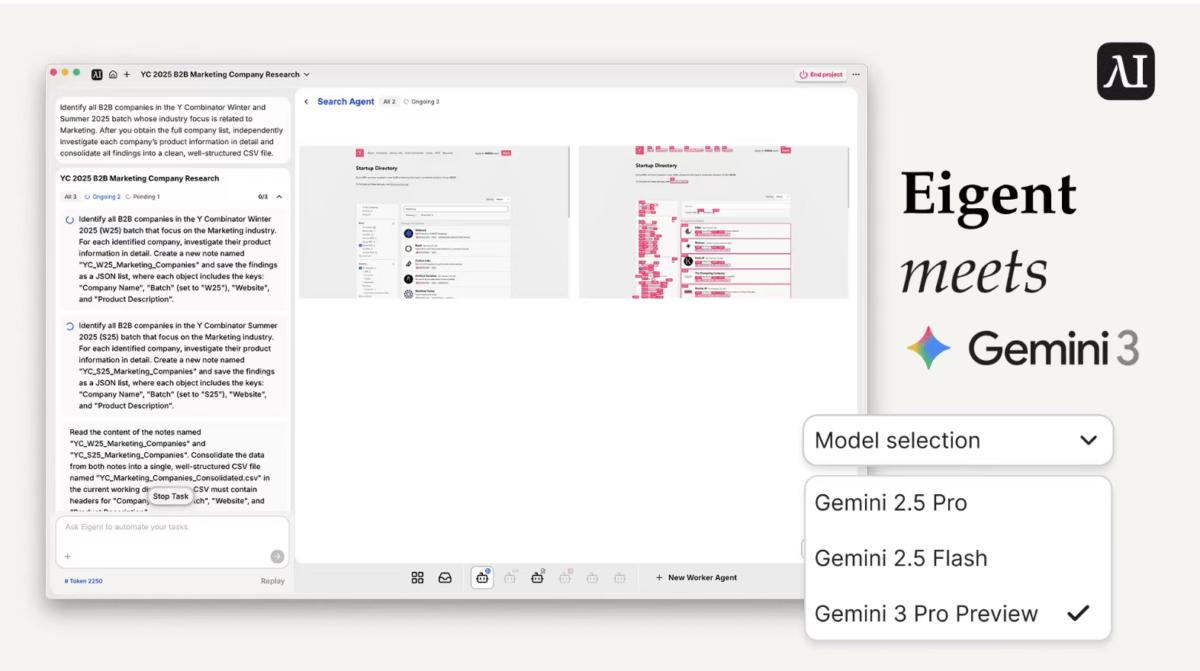In the competitive Software as a Service (SaaS) industry, businesses need reliable metrics to calculate the health and potential of their companies. That is why the rule of 40 is popularly used to learn the balance between the growth and profitability of a business.
This rule can benefit both investors and entrepreneurs by helping them understand how to strive for sustainable success. In this article, we will explore how the rule of 40 works for SaaS companies and how it can benefit them.
Explaining the Rule of 40 in Terms of SaaS
The Rule of 40 is a standard benchmark used in the SaaS industry to evaluate the balance between growth and profitability of a company. In the rule of 40 calculation, a SaaS company’s combined revenue growth rate and profit margin should equal to or more than 40%. This percentage assesses whether a company is achieving a healthy equilibrium between growing its market presence while also increasing its profit share.
Why Is the Rule of 40 Used in the SaaS Sector?
It is because this rule recognizes the high growth potential of subscription-based models that SaaS companies and products usually offer. Meanwhile, the rule ensures that this growth does not come at the expense of profitability. Also, this versatile metric can be adapted to different stages of a company’s lifecycle.
Early-stage companies like startups focus more on rapid growth, which potentially sacrifices their short-term profitability. On the other hand, more mature companies prioritize maintaining or increasing profitability as growth stabilizes. So, by applying the Rule of 40, SaaS companies are able to make strategic decisions that align with their long-term objectives and fluctuating market conditions.
Components of the Rule of 40
There are two main components that are a part of the rule of 40 calculation:
Revenue growth
This represents the year-over-year percentage increase in a company’s revenue. It reflects how quickly the company is growing its product lines. SaaS companies usually calculate this using Monthly Recurring Revenue (MRR) or Annual Recurring Revenue (ARR).
Total revenue growth can be used for companies that have less than 80% of their revenue coming from subscriptions. This metric is used because it helps to assess how effectively a company is acquiring new customers.
Profit Margin
This component of the rule of 40 measures the percentage of revenue a company retains as profits after accounting for all direct and indirect costs. It is used as an indicator of the company’s efficiency in cost management and profitability.
In the Rule of 40, the profit margin is usually represented by the EBITDA margin (Earnings Before Interest, Taxes, Depreciation, and Amortization). EBITDA is a non-GAAP metric that clearly shows operational profitability by excluding non-operational expenses. EBITDA margin is particularly useful for SaaS companies that rely heavily on cloud services.
Note: EBITDA margin is useful for SaaS companies because it focuses on core operating performance without considering financing, tax structures, or capital expenditures.
However, depending on the company’s business model and financial strategy—other profit measures like EBIT (Earnings Before Interest and Taxes), net income, or free cash flow can also be used.
The Rule of 40 combines these two components to assess a company’s overall health. For example, a company with a 25% revenue growth rate and a 15% EBITDA margin would meet the Rule of 40. This will indicate a balanced approach to scaling its business and managing costs.
How to Use the Rule of 40 SaaS?
Now that you know the components of the rule of 40, it is easier to calculate it. Just know that ideally, the result should be equal to 40%.
Rule of 40 Formula Application
Here is the formula for the rule of 40 calculation:
Rule of 40 = Revenue Growth Rate+ EBITDA Margin
Here is how you can calculate revenue growth:
- Revenue Growth Rate = ((Revenue in Current Period – Revenue in Previous Period)/Revenue in Previous Period)*100
EBITDA margin can be calculated using this formula:
- EBITDA Margin = (EBITDA/Total Revenue)*100
Steps for the Easy Way of Rule of 40 Calculation
- Calculate the revenue growth rate using the given formula.
- Calculate EBITDA:
EBITDA = Net Income+Interest+Taxes+Depreciation+Amortization
- Now calculate the EBITDA margin.
- Combine the two percentages to get the Rule of 40 score.
So, this is the simplest way of calculating the rule of 40.
Important Tip: A Rule of 40 score of 40.83% indicates a balanced and healthy SaaS company, according to the Rule of 40 benchmark.
Benefits of Using the Rule of 40
You must be thinking what are the benefits of using this rule of 40 formula? Here are the main reasons this formula is helpful for companies:
1) Figuring Out Which Trade-Offs to Afford
The Rule of 40 helps businesses decide how to balance growing fast and making money. If a company is growing quickly but not making much profit, or vice versa, the Rule of 40 can guide them to find a better balance. This way, they can see if they can afford to spend more on growth or if they need to focus on making more profit.
2) Assessing Investment Ability
Investors use the Rule of 40 to understand if a company is worth investing in. A high Rule of 40 score shows that a company either grows quickly, makes good profits, or both. This means the company is likely managing its resources well and is a good candidate for investment.
3) Compare Invest Opportunities
When investors are looking at different companies to invest in, the Rule of 40 makes it easy to compare them. They look at different companies’ scores according to this 40% ratio to quickly see which companies have a good balance of growth and profitability. This turns out to be easier for choosing the best investment opportunities.
4) Maximizing Growth and Profitability
The Rule of 40 also helps companies focus on both growing their business and making money. It helps companies realize if their profit margin and revenue growth have a huge disparity in their ratios or not. So, by keeping an eye on their Rule of 40 scores, companies can make smarter decisions to boost their growth while improving their profits. This leads to a healthier, more successful business in the long run.
Examples of SaaS Companies Who Have Achieved the Rule of 40
Did you think that the rule of 40 is unachievable? Not at all! Many top SaaS companies are successful in this rule. Let’s see their examples:
Salesforce
Salesforce is one of the top cloud-based CRM platforms that has consistently shown the ability to balance rapid growth with operational efficiency. That’s why it is a prime example of a company achieving the Rule of 40. Salesforce has managed to maintain high revenue growth rates through its huge range of products, strategic acquisitions, and global expansion.
At the same time, the company has focused on profitability by using the power of economies of scale. Salesforce has been optimizing its sales and marketing expenses and continually innovating its product offerings. This balance of growth and profitability has allowed Salesforce to deliver impressive financial performance.
Zoom Video Communications
Do you all remember how everyone needed Zoom at the time of COVID-19? Zoom has become famous for its video conferencing feature, especially during the pandemic when remote work increased. This explosive revenue growth was driven by its user-friendly interface, reliable performance, and scalability to handle both small meetings and large webinars.
The company has invested heavily in IT infrastructure to support this growth but has also maintained a strong focus on operational efficiency. This dual focus has enabled Zoom to achieve significant profitability while continuing to expand its market presence. That is how the company has positioned itself well within the Rule of 40 framework.
Shopify
Shopify is an e-commerce platform that helps businesses create online stores and has shown remarkable growth since this business started. Shopify’s revenue growth has been fueled by the increasing demand for online retail solutions, especially during the COVID-19 pandemic. The company’s ability to provide a scalable, user-friendly platform with lots of integrated services has attracted a huge customer base.
Despite substantial investments in technology and customer support to maintain its rapid growth, Shopify has achieved a healthy EBITDA margin. The company achieved this by controlling its operating costs and leveraging its growing user base. This balance of rapid expansion and controlled spending has helped Shopify meet the Rule of 40.
Adobe
Adobe which is particularly known for its Creative Cloud suite, is also a rule of 40 company. It transitioned successfully from a traditional software licensing model to a subscription-based SaaS model. This shift enabled Adobe to achieve significant recurring revenue growth while maintaining strong profitability.
Adobe’s continuous value delivery through regular updates, along with its expanded digital media and marketing services, has driven customer retention and acquisition. Their efficient operational management and strategic investments in innovation and AI capabilities have given them a good EBITDA margin. So, with this consistent revenue growth and profitability, Adobe successfully meets the Rule of 40.
What Is the Indicator of a Good SaaS Company Growth Rate?
Over time, industry analysts and investors have observed that successful SaaS companies usually achieve a combined growth rate and profitability margin of around 40%. This threshold has emerged as a practical standard for comparing companies that balance aggressive growth strategies with proper financial management.
Investors use the Rule of 40 as a quick metric to evaluate the health and potential of SaaS companies. A score of 40 or higher generally indicates that a company is managing its resources well, growing sustainably, and is likely to provide good returns on investment. Companies that score below 40 might need to reconsider their strategies to improve either growth or profitability. Also, the Rule of 40 is flexible enough to apply to companies at different lifecycle stages.
How to Control Your Profit Margin While Achieving the Rule of 40?
Here are some strategies to help you manage your profit margin effectively:
1) Focus on Efficient Growth
Invest in marketing and sales strategies with a high return on investment (ROI). Use data analytics to identify the most cost-effective channels and campaigns. While doing these, also focus on your customer service, support, and engagement to reduce customers who bounce from your website. It is important because retaining customers is cheaper than acquiring new ones and also contributes to consistent revenue growth.
2) Streamline Operations
Use technology to automate repetitive tasks as it reduces labor costs and increases efficiency. Businesses can outsource functions like HR, IT support, and accounting to specialized BPO firms to save costs and focus on core business activities. It also helps in implementing lean management principles to eliminate waste and improve operational efficiency.
3) Enhance Pricing Strategies
Set prices based on customer value rather than just the cost. This can help you capture more revenue from customers who derive significant value from your product. Additionally, you can provide multiple pricing tiers to cater to different customer segments as it maximizes revenue across various customer types.
4) Control Costs
Companies should also regularly review and negotiate contracts with suppliers and service providers. These things help in reducing variable costs without compromising on quality.
Implement strict budgeting and forecasting processes to keep expenses under control. Also, regularly compare actual spending to the budget to identify and address variances. Remember that negligence in financial management is a common reason for companies to incur unnecessary losses.
What Is the Weighted Rule of 40?
The Weighted Rule of 40 is an adaptation of the traditional Rule of 40, designed to provide a more detailed assessment of a SaaS company’s performance. It gives different weights to growth and profitability. This approach recognizes that not all growth and profitability are equal in importance at different stages of a company’s lifecycle or in various market conditions.
Instead of simply adding the revenue growth rate and profitability metric, the Weighted Rule of 40 assigns different weights to each component based on their perceived importance. The formula looks like this:
Weighted Rule of 40 Score = (w1*Revenue growth rate) + (w2*profitability metric)
The weights are determined based on the company’s strategy, market conditions, and lifecycle stage. For example:
- Early-Stage Companies: These companies prioritize growth over profitability. Therefore, a higher weight is assigned to the revenue growth rate (e.g., 70%) and a lower weight to profitability (e.g., 30%).
- Mature Companies: These companies prioritize profitability as their growth stabilizes. Therefore, a higher weight is assigned to profitability (e.g., 60%) and a lower weight to growth (e.g., 40%).
Conclusion
As discussed in this blog, leading SaaS companies have effectively balanced growth and profitability to achieve the Rule of 40. You can observe that each company has leveraged its unique strengths to sustain high growth rates while maintaining strong profit margins.
These strategies show us that their financial health and operational excellence are benchmarks for other SaaS companies wanting to achieve similar success. Remember that balancing growth and profitability through the rule of 40 is an effective way of managing your company’s overall health and potential.








